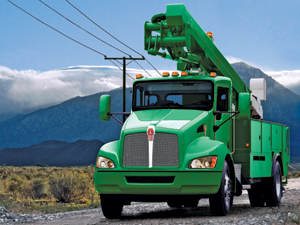Fulfilling Your Medium Duties

“Customer expectations of medium-duty trucks have continued to increase in recent years,” said Judy McTigue, medium-duty marketing manager for Kenworth Truck Co. “Many users look for a business solution that provides superior uptime and reliability. An increased focus on fuel efficiency and efforts to reduce the environmental footprint are driving interest in hybrids. Dependability is also high on the list because, day in and day out, medium-duty trucks are work trucks and customer satisfaction is based on making timely deliveries, pickups or service calls.
For years, a key criterion for spec’ing medium-duty trucks has been the gross vehicle weight rating (GVWR). Users select trucks primarily on the basis of their class.
But a medium-duty truck is not just any truck — it’s the wheels of your business, carrying crews and pulling pieces of equipment. For starters, medium-duty trucks fall into the Class 5 (16,001- to 19,500-lbs GVWR), Class 6 (19,501- to 26,000-lbs GVWR) and Class 7 (26,001- to 33,000-lbs GVWR).
Know your payload, terrain conditions and body requirements and you’ll be on the way to developing a good understanding of how to spec your medium-duty truck chassis for your business application. While the vehicle’s GVWR is still important, buyers are increasingly focusing on other factors.
“For example, how many fires is it acceptable not to respond to because your town’s pumper truck is down for servicing? Or how many missed residential propane deliveries are allowable in the dead of a cold winter?” asked McTigue. “Your medium-duty truck must stay running because it’s not easy to rent when it’s down, unlike a tractor pulling a trailer. Think of it like a house. Your medium-duty truck chassis is very similar — you need it to deliver your goods or services, each day, all day. You wouldn’t build a house for your family on a foundation that will give way before the house itself.”
Body Wisdom
Some of the first things to consider are the type of load, annual mileage and type of operating environment. Buyers can choose from a wide range of bodies that can be mounted differently depending on the truck’s wheelbase and local weight regulations.
“Bodies are mounted flush with the cab or with a space in between,” McTigue explained. “They can also be on top of the frame or extend below it. Kenworth’s body builder options help the body builder with this process. Frame strength and length can be determined when we know the type of body selected. Typically, the big issue with a frame isn’t just the kind of load, but also the body type and vehicle application. For example, there’s no problem with a truck-mounted crane when it’s traveling down the road mounted. But when it’s parked and lifting loads, we need to have a better understanding of the weights and stresses that will be placed on the vehicle.”
The Drivetrain
A carefully spec’d drivetrain can lower your total operating costs over the truck’s life. Be careful not to over-spec the engine.
“In a fire and rescue application, you’re going to need high horsepower and torque to get good acceleration. But in most pickup and delivery applications, you aren’t going to need nearly the same amount,” McTigue said. “A manual transmission may be best if you either have an experienced driver or don’t make frequent deliveries. An automatic or automated transmission may be a better fit if you either have a new driver or routes with frequent stops.”
Whether you select manual or automatic, you should choose the rear axle ratio carefully to get the best fuel economy. “Pick something that will provide the startability needed based on the load that will be carried, but also keeps the engine in the most fuel-efficient operating range as long as possible.
“As it is with many of the other specs, it all comes down to finding the right balance,” McTigue concluded.

Comments are closed here.